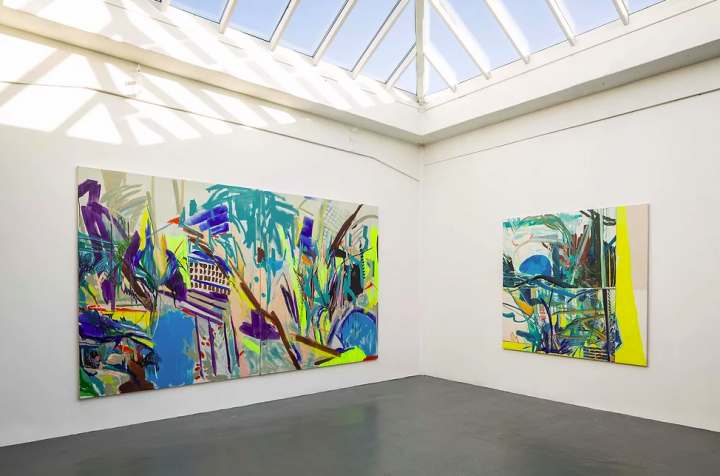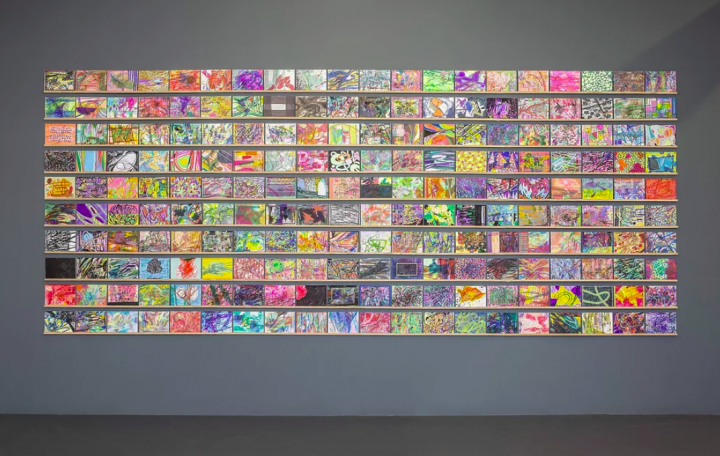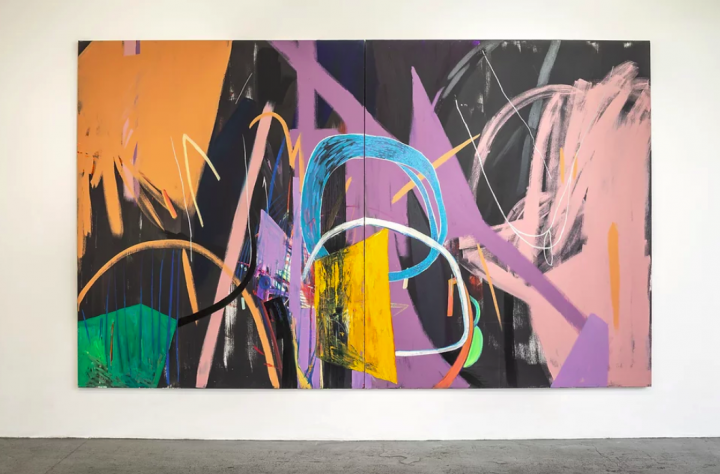Scottish Art News
Latest news
Magazine
News & Press
Publications
Drawn from Memory
By Greg Thomas, 04.02.2022

During the Covid-19 lockdown, the Glasgow-based painter Sin Park (b. 1987) received a welfare visit from her landlord: “she told me that the previous tenant of this flat was an old lady. She was quite alone: she didn’t have family or friends. But she always looked happy. So my landlord would ask her, what’s your secret? And she said – there’s a long motorway outside my window – she said she saw the cars as her friends. And she observed little changes in the landscape. It sounded a bit creepy initially, but then I realised that’s exactly what I was doing. I was looking outside and trying to capture the drama in the sky, in the traffic, small changes in the colours of the leaves...”
Thrown back like so many of us on solitary routines and coping strategies, South-Korean artist Park also found herself without the space or materials to create her signature, large-scale abstract oils. All she had was the shifting view from her one large window – high up in a central Glasgow apartment block – and an A5 sketchpad with coloured markers. The window became a “portal”, as she puts it, the flickering cityscape a ballet of colours and textures that inspired her Drawings from Isolation: 1-200. Underpinning the process was that sense of emotional attunement to inanimate objects and processes that kept the previous resident’s spirits up. I even gather in interview that the title of Park’s recent show at Patricia Fleming Gallery, 'Dance With the One Who Brought You', expresses a sense of gratitude to the cars, trees, and other surroundings of her flat, as if they were faithful friends deserving thanks.
Drawings from Isolation unfolds a kaleidoscope of colour and pattern, at once joyful and subtly manic-seeming. Larger shapes and motifs suggest window panes, air vents, or quivering leaf cover, but they overlap with, and unfold into, luminous depths of texture—dots, squiggles, stripes. The almost synthetically bright colour palette is continuous with that of Park’s larger works. She puts her tonal range down to the ambient effects of social media, and the McLuhanite digital soup more generally: “whenever we scroll we see a thousand colours. Everything is flickering. Whenever you see TV, Instagram, internet, you are exposed to a lot of colours. That certainly influenced my paintings.”
 Sin Park, Drawings from Isolation 1-200, 2020. Courtesy of the artist and Patricia Fleming Gallery. Photo: Keith Hunter.
Sin Park, Drawings from Isolation 1-200, 2020. Courtesy of the artist and Patricia Fleming Gallery. Photo: Keith Hunter.
Park’s story begins with a set of more homely recollections, however. In Seoul, her father was an amateur art collector and friendly with many calligraphers, painters, and architects. The artist remembers as an eight- or nine-year-old being woken up by a raucous party and coming downstairs. “Everyone was so drunk! There was one man—a calligrapher, but to me he looked like a hobo. He had a beard and very long hair. He asked me to bring the soy sauce over, so I said ‘OK’. And he kind of used his hair as a brush, dipping it in the soy sauce and drawing a big dragon on the back of a calendar. That was a really eye-opening experience. I thought ‘oh my god, I want to be like him! I want to make something out of nothing’.” There are also memories of hiking in the mountains next to her home: “I would often go there and see the organic movement of the sky, the trees, leaves. Every day I was taking the same route but it was different scenery, different impressions.”
Park’s painting is concerned with memory, and with biographical narrative more generally: the creative processes by which we draw meaning from them, but also the ways in which they emerge from, and recede into, a morass of disconnected thoughts and feelings. According to an artist’s statement, “I am interested in notions of memory and not-knowing as methods for approaching painting…Predetermined actions set against the potential of active eruptions…moments in which the activity stretches into a space that is not known.” Critical reference-points for this way of thinking have been established during an ongoing PhD at Glasgow School of Art. Perhaps especially significant are Bergson’s theories of perception and the role of images in memory formation.
It's equally interesting to see how the above dialogue plays out in the paintings, however. In larger works from the recent show, such as Her Blue Sky, An Attempt at Dialogue and the title-piece Dance With the One Who Brought You, it’s possible to identify an underlying architecture of larger, horizontal and vertical coloured planes, or to pick out features of landscape, flora, or architecture. But these are often obscured by an overlaid meshwork of thin scribbled lines that have less formal regularity, sometimes seeming to push the whole composition towards the edge of collapse. It’s as if moments of coherent reminiscence or symbolic gesture were seguing in and out of a more automatic, abstract mark-making process.
 Sin Park, The Shape of Evidence, 2017. Courtesy of the artist and Patricia Fleming Gallery. Photo: Keith Hunter.
Sin Park, The Shape of Evidence, 2017. Courtesy of the artist and Patricia Fleming Gallery. Photo: Keith Hunter.
The orthographic or writerly qualities of these marks are interesting to consider—the method approaches asemic poetry at points. Park mentions a discussion during a recent residency with a technician, who suggested she apply some of her oils with a syringe, “almost like hand-drawing, or using a pen.” She also recalls her training in calligraphy at school: “whenever you do calligraphy, there’s a moment when you put in a lot of strength, and then you release the power. There is a certain fluidity. Now, whenever I put a brush-mark on the surface I think ‘ok this bit needs more power, this needs less’. So there is probably a co-relationship there.”
Then again, an equally important feature of many of Park’s works is that they start from pictures of things, and therefore offer an implied viewing position. I put it to her that she’s part of a new generation of painters (also including artists such as Jadé Fadojutimi and Rachel Jones) for whom abstraction does not necessarily entail that impulse towards pure impersonality or objectivity, stereotypically ‘male’, that defined the New York School. Abstraction can now be about biography, personality, identity: perhaps especially identities that have been ignored in the past. “I don’t know…I’m aware there’s a certain trend…Some of the painters who are now well-known from that generation are my friends…But I’m not following any particular current.” The reframing of historical narratives of abstraction, including by emphasising the role of women, has been more important: “Hilma af Klint, Lee Krasner, people like this have been put in the spotlight with shows over the last couple of years, and I was really keen to learn about that.” Amy Sillman and Clarice Lispector are also cited as influences, for their writing as much as their visuals.
If nothing else, Park’s painting anchors the unknown and the dreamlike in a bedrock of familiarity, even domesticity (to risk a term best used sparingly in relation to women artists). This is painting with a vaulting spirit but its feet on the ground. “The main purpose of the art is knowing myself better,” she says, “by saying something that’s not quite knowable.” A familiar story made new.
Dance With the One Who Brought You ran from 9th December 2021 until 30th January 2022 at Patricia Fleming Gallery.




